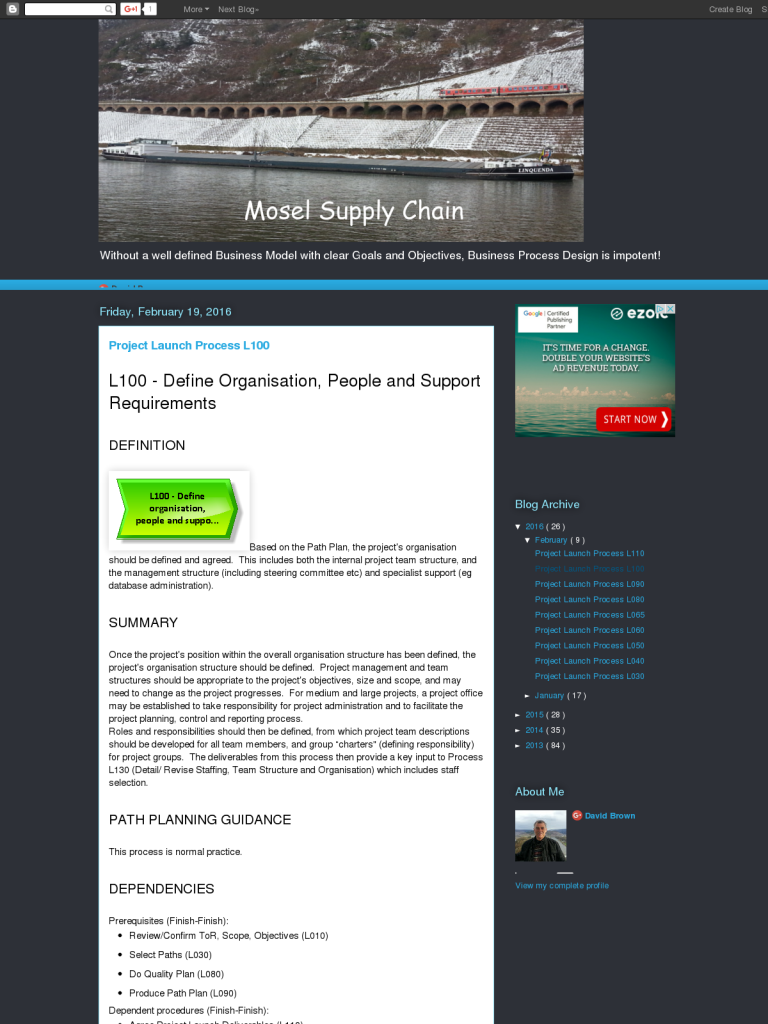Project Launch Process L100
Blog: Biz-Performance, David Brown
L100 – Define Organisation, People and Support Requirements
DEFINITION
SUMMARY
Once the project’s position within the overall organisation structure has been defined, the project’s organisation structure should be defined. Project management and team structures should be appropriate to the project’s objectives, size and scope, and may need to change as the project progresses. For medium and large projects, a project office may be established to take responsibility for project administration and to facilitate the project planning, control and reporting process.
Roles and responsibilities should then be defined, from which project team descriptions should be developed for all team members, and group “charters” (defining responsibility) for project groups. The deliverables from this process then provide a key input to Process L130 (Detail/ Revise Staffing, Team Structure and Organisation) which includes staff selection.
PATH PLANNING GUIDANCE
This process is normal practice.
DEPENDENCIES
Prerequisites (Finish-Finish):
-
Review/Confirm ToR, Scope, Objectives (L010)
-
Select Paths (L030)
-
Do Quality Plan (L080)
-
Produce Path Plan (L090)
Dependent procedures (Finish-Finish):
-
Agree Project Launch Deliverables (L110)
-
Detail / Revise Staffing, Team Structure and Organisation (L130)
RECEIVABLES
-
Project Constitution (L010)
-
Quality Plan (L080)
-
Path Plan (L090)
DELIVERABLES
-
Project Organigramme
-
Project Job Descriptions and Charters
TOOLS
-
Guidelines: PROLES – Project Roles
-
ITPM Core Guide
DETAILED DESCRIPTION OF TASKS
Define the Project’s Position within the Overall Organisation Structure
The project manager should define the project’s position within the organisation, and in so doing should meet with key senior managers to:
-
evaluate relative levels of support for the project within corporate divisions / departments,
-
identify primary influencers (and key areas of resistance) among the senior management group (some of this may have been done in process L050 Define & Agree Change Management Approach) and other processes looking at change issues,
-
determine the degree of interaction required with existing bodies such as technology executive committees or project standards boards etc,
-
target potential members for the project’s steering committee.
Design the Project Organisation Structure
Designing the project organisation structure involves defining:
-
the project management structure – This would normally include team management, project office management, quality assurance management, the project manager, the project steering committee, project sponsor and director, and any user groups. A project management structure differs from a line management structure because a project demands tighter control and a more focused management orientation. For this reason there should be more management positions (with fewer people reporting to a manager) than in a line organisation.
-
the project team structure – The size and complexity of the project generally dictates how the project teams will be organised, but there are general guidelines to be followed (see ITPM Core Guide) covering, for example, the integration of functional and technical roles within teams, the integration of sub-contractors into teams, and not exceeding recommended team sizes or staff-manager ratios.
The project office has a key role in the effective running of medium to large projects. It provides a central coordination point for all project related information, and allows the project manager to delegate project administration to a specialist function. The project office should ensure that project planning, monitoring, reporting and control mechanisms are in place, and support team leaders / managers in the development of their detailed work plans.
The organisation structure should be viewed as dynamic, and changes should be anticipated by the project manager as the project evolves; the organisation should be reviewed as part of the detailed (segment) planning process to ensure the structure is appropriate for the work being planned.
Other formats of project organisation may be appropriate. The following two charts show example project organisations for the “Project Model” and “Design/Prototype/Construct” phases of a project to implement integrated SAP systems.
Document Project Roles and Responsibilities
The project organisation structure, type of project, size, methodologies used and functional / technical responsibilities of the teams will influence the roles and responsibilities identified and their definition, but these would typically cover:
-
Project sponsor – “Champion”, owner and financier of the project,
-
Project director – Executive agent of project sponsor,
-
Steering committee – Responsible for executive project oversight, direction setting, decision making support,
-
User group – User acceptance of major deliverables,
-
Project manager – Overall project co-ordination, management and control,
-
Team leaders / managers – Day-to-day management and control of detail work plan efforts,
-
Project team members – Task completion.
Develop Project Job Descriptions and Charters
-
Project – Job Descriptions -These should be developed for all team members, defining reporting relationships, responsibilities and skill / experience requirements. The roles, responsibilities and reporting structure may be represented on an “organigramme” organisation diagram.
-
Charters – For groups (eg steering committee and user group) formal charters should be prepared. They should be concise and document the primary purpose/ objective of the group, responsibilities, membership and meeting frequency.
Select the Project Team
Key participants such as the project’s sponsor, Project Director and Project Manager will normally have been identified by this stage. The selection or acquisition of other required resources normally takes place as part of Process L130 (Detail / Revise Staffing, Team Structure and Organisation), and the deliverables from this process are a key input.
Further details on the type of resources and the structuring of project teams may be found in Process L130.
Leave a Comment
You must be logged in to post a comment.








